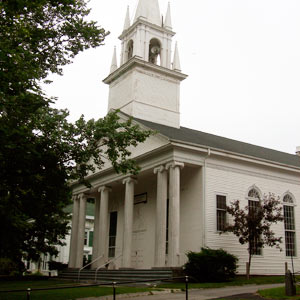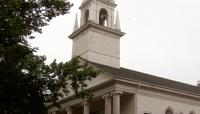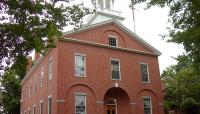Landscape Information
Samuel de Champlain passed through Wiscasset Harbor in 1605 and the town was settled soon after. It was abandoned in 1675 due to King Philip’s War, resettled, and incorporated in 1760. The common was laid out during the Revolutionary War as a militia training ground. Unlike typical commons on level lots, the Wiscasset common was located on sloping land overlooking the tidal Sheepscot River. Originally rectangular in shape, it was triangular by the 1870s, the same decade that elms in formal rows were planted, some of them lining bare-earth footpaths. A wooden concert bandstand without a roof was added in 1885, with a Civil War-era cannon nearby. In the 1920s the Village Improvement Society added a boulder monument dedicated to those who served in World War I.
Today the common’s southern, sloping half remains, with two historic buildings at the top of slope, facing the river: the Georgian-style Lincoln County Courthouse (1818- 1824) and the white-columned Congregational Church (1909). The elms fell to Dutch elm disease and were replaced by randomly planted deciduous and evergreen trees. The bandstand and random footpaths no longer exist. Despite its slope and high traffic location, the common is used seasonally for public gatherings. It is part of 1,010 acres in the Wiscasset Historic District, listed in the National Register of Historic Places in 1973.






